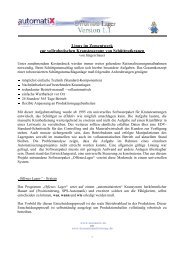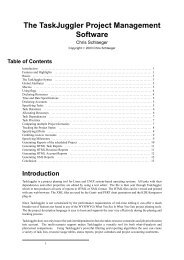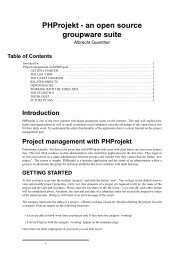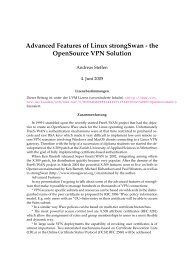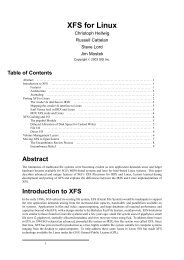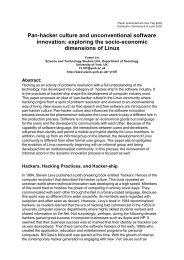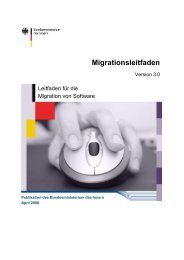The FlightGear Flight Simulator History, status and future
The FlightGear Flight Simulator History, status and future
The FlightGear Flight Simulator History, status and future
Create successful ePaper yourself
Turn your PDF publications into a flip-book with our unique Google optimized e-Paper software.
6. Veridian Engineering Division, Buffalo, NY.<br />
<strong><strong>Flight</strong>Gear</strong> is used for the scenery <strong>and</strong> out-thewindow<br />
view for the Genesis 3000 flight simulator.<br />
Reselling open source software has not been a good<br />
revenue source for other companies, partly because of<br />
the rapid version changes <strong>and</strong> partly because of the<br />
low cost of b<strong>and</strong>width for the consumer. Yet, several<br />
organizations are also considering making retail versions.<br />
Can <strong><strong>Flight</strong>Gear</strong> be a viable profit center?<br />
Suppose we separate the database of visual scenery<br />
from everything else. That everything else is only few<br />
megabytes, which easily fits into a corner of a CD <strong>and</strong><br />
will readily be downloaded whenever a new version<br />
becomes available. As with many other GUI packages,<br />
it will probably be repackaged by the distributions to<br />
ensure a painless installation for the community. <strong>The</strong>re<br />
appears to be little benefit in making a product here,<br />
especially since closed source flight simulator games are<br />
available at under ����© .<br />
In contrast, the scenery is more than a gigabyte for each<br />
continent, is unlikely to get any smaller, <strong>and</strong> represents<br />
a significant download. <strong>The</strong> scenery is relatively stable<br />
over time, old versions are usually useful with newer<br />
releases of the binary software, <strong>and</strong> the upgrades only<br />
add detail to an existing <strong>and</strong> viable database. <strong>The</strong>re is<br />
clearly an opportunity to retail a DVD (or a dozen CDs)<br />
that contain the scenery. <strong>The</strong> marginal cost of adding<br />
a few dozen binaries, for popular operating system<br />
distributions <strong>and</strong> driver combinations, is probably trivial.<br />
Thus, this retail package is likely to be fully functional.<br />
Alternatively, suppose we consider the pilot’s viewpoint.<br />
Most general aviation aircraft cruise at below 200 knots<br />
<strong>and</strong> flight visibility is (in real life) usually below 20<br />
miles for the lower altitudes that are accessible with<br />
ordinary non-turbocharged piston engines. Even when<br />
flying in a straight line, a maximum of 8000 square<br />
miles of new terrain will come into view during each<br />
hour of flight. Currently, the database uses about one<br />
megabyte for 600 square miles, so a streaming rate of 12<br />
megabytes/hour will be sufficient. <strong>The</strong> rate will be lower<br />
when previously-downloaded scenery is in view.<br />
This need not impact the core <strong><strong>Flight</strong>Gear</strong> source code.<br />
<strong>The</strong> latitude <strong>and</strong> longitude of the aircraft are already<br />
exported for use by independent programs, so the center<br />
of interest is trivially available. Since the scenery is<br />
stored in ¢�©�©�£¦¥�� pieces, an independent program need<br />
only generate a list of the closest elements that have not<br />
been fetched yet, <strong>and</strong> issue a wget to ensure that they<br />
will be available before the aircraft gets close enough for<br />
the pilot to see them.<br />
A 56K modem is capable of 12 megabytes per hour<br />
before compression. If streaming scenery can be delivered<br />
essentially through any internet connection, it might<br />
remove the market need for retail scenery packages.<br />
Multiplying this b<strong>and</strong>width by a worldwide community<br />
of users will result in a sizeable traffic impact on the<br />
distributing servers. Is the total still going to be low<br />
enough to be supported for goodwill, or will free servers<br />
gradually transition to monthly access fees <strong>and</strong> maybe<br />
even deliver proprietary content?<br />
Simulating <strong>Flight</strong> Training<br />
<strong><strong>Flight</strong>Gear</strong> could also be helpful when learning to fly<br />
aircraft. <strong>Flight</strong> training is carefully regulated by the<br />
government, to ensure that aircraft generally stay in the<br />
sky until their pilot intends for them to come down safely.<br />
<strong>The</strong>re are thus some real concerns which need to be<br />
addressed before authorities can approve a system.<br />
1. Do the controls feel, <strong>and</strong> operate, sufficiently like<br />
the ones in the aircraft that a pilot can use them<br />
without confusion? Are they easier to use <strong>and</strong>/or<br />
do they obscure dangerous real-life effects?<br />
2. Does the software provide a forward view that<br />
is representative for the desired training environment?<br />
3. Are the instruments drawn such that a pilot can<br />
easily read <strong>and</strong> interpret them as usual? Do<br />
they have the systematic errors that often cause<br />
accidents?<br />
4. Can all needed cockpit switches <strong>and</strong> knobs be<br />
operated intuitively?<br />
5. When operated in the limited envelope of flight<br />
configurations that is applied to the training activity,<br />
does it match the manufacturer’s data for the<br />
aircraft performance?<br />
6. Are the weather settings accessible <strong>and</strong> intuitive to<br />
the instructor? How about causing system failures<br />
<strong>and</strong> broken instrumentation?<br />
7. Can the pilot conduct normal interactions with air<br />
traffic control? Can the instructor easily determine<br />
whether the pilot is complying with the control instructions<br />
<strong>and</strong> record errors for subsequent review?<br />
8. Is the pilot’s manual for the simulator similar <strong>and</strong><br />
arrangement to that of an aircraft, such that it can<br />
readily be used in flight?<br />
9. Can all maneuvers be performed in the same way<br />
as in an aircraft?<br />
In that (partial) list of concerns, the quality of the actual<br />
flight simulation (which is really what <strong><strong>Flight</strong>Gear</strong> is<br />
offering) is a minor topic <strong>and</strong> <strong>and</strong> acceptable performance<br />
is easily achieved. In contrast, a large package of





